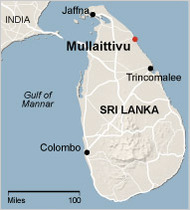Ilankai Tamil Sangam30th Year on the Web Association of Tamils of Sri Lanka in the USA |
||||
 Home Home Archives Archives |
Sri Lanka Forces Blamed for Most Civilian Deathsby Lydia Polgreen, The New York Times, May 16, 2010
Tens of thousands of Tamil civilians died in the last, bloody months of Sri Lanka's civil war, the International Crisis Group said in an investigative report to be released Monday, most of them as a result of government shelling of areas that were supposed to be safe zones.
The report, which cites witness testimony, satellite images, documents and other evidence, calls for a wide-reaching international investigation into what it calls atrocities committed in the last months of the Sri Lankan government’s war against the Tamil Tiger insurgency. The war ended a year ago, when the Tigers’ top leadership was killed on a narrow strand of beach in northeastern Sri Lanka, capping a two-decade armed struggle by a group that pioneered some of the ugliest insurgent tactics in the world, including female suicide bombers and child soldiers. Because the government barred independent journalists and most humanitarian workers from the war zone, the death toll of the final months of fighting, when at least 300,000 Tamil civilians were pinned down on a beach, caught between the rebels and government forces, is not known. United Nations workers counted about 7,000 dead in the last weeks of April, just before the last phase of the fighting, but diplomats, aid workers and human rights activists have long argued that those figures far underestimated the dead and did not include the final weeks of battle. Government officials, meanwhile, have repeatedly denied singling out civilians, and have said that the total number of people killed is much lower. Sri Lankan officials declined to comment on the report, saying they had not yet seen it. The report by the Crisis Group, an advocacy organization based in Brussels and Washington that seeks to resolve and prevent armed conflicts, said that despite its promises to protect civilians and aid workers as it made its assault on the Tigers, the Sri Lankan government had bombed relentlessly in areas where it knew unarmed people were present. “Evidence gathered by Crisis Group provides reasonable grounds to believe that during these months the security forces intentionally and repeatedly shelled civilians, hospitals and humanitarian operations,” the report said. “It also provides reason to believe that senior government and military officials were aware of the massive civilian casualties due to the security forces’ attacks, but failed to protect the civilian population as they were obliged to under the laws of war.” The report said that the insurgents, known as the Liberation Tigers of Tamil Eelam, also committed atrocities, particularly in choosing to corral as many people as possible around its fighters, hoping to maximize civilian casualties and force international intervention. “Their calculation, ultimately an incorrect one, was that escalating civilian casualties would eventually get the attention of the international community to broker a cease-fire so the L.T.T.E. could regroup or perhaps enter negotiations,” the report said, using initials the Tamil Tigers are also known by. Instead, the Sri Lankan government pressed the rebels to the bitter end. Tamils who tried to escape were killed, children were forced to fight, and the sick and wounded were left to die, the report said. But it was the Sri Lankan government, the report concluded, that carried the greatest responsibility for the killing. “All but a small portion of these deaths were due to government shelling,” the report said. A version of this article appeared in print on May 17, 2010, on page A6 of the New York edition. |
|||
|
||||
